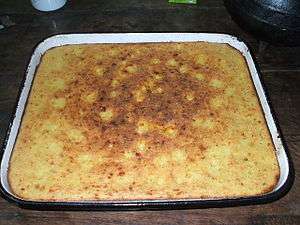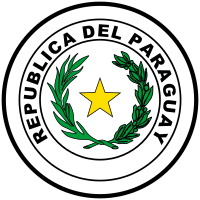Paraguayan cuisine
The cuisine of Paraguay is the set of dishes and culinary techniques of Paraguay. It has a marked influence of the Guarani people, in fusion with the Spanish cuisine and other marked influences coming from the immigration received by bordering countries such as Italian cuisine and Portuguese food. The gastronomy product of the syncretism and Hispanic-Guaraní fusion, is of greater weight in the Paraguayan history and considered the mother of the whole region, having Asunción as the starting point of many Spanish expeditions in the Southern Cone.[1] It is worth clarifying that in society Paraguayan, the exchange of knowledge occurred between mestizos, criollos and guaraníes, before and even after the Jesuit missions. In 2017, the Ministry of the National Secretariat of Culture of Paraguay decided:
"Declare as 'Intangible Cultural Heritage of Paraguay' the production, handcrafted and traditional production of four typical Paraguayan meals still in force such as vori-vori, locro, Paraguayan soup and jopara (mixed bean and locro) and its recipes, knowledge, practices and knowledge that are passed down from generation to generation and document the material and immaterial elements associated with it (such as corn, in its different varieties) as a cultural manifestation. "[2]

Ingredients
Meat, vegetables, manioc,[3] maize,[3] and fruits are common in Paraguayan cuisine.[4] Barbecuing is both a cooking technique and often a social event, and are known as the Asado. Many dishes are based on corn, milk, cheese and meat, and fish caught in rivers are also eaten.[5] There are about 70 varieties of chipa (cake) in Paraguay. Most chipas are made from manioc flour, which is derived from cassava, and cornmeal.
Common dishes

- Dumplings.[4]
- Chipa is a bread made with manioc, egg and cheese.[4]
- Chipa Guasú is a cake made with corn grains, and is an original and common food of Paraguay. It's often served at the asado.
- Chipa so'o is another type of cake.
- A traditional kiveve is made using pumpkin or "andai", water, salt, oil, onion (chopped into very small pieces), milk, sugar, corn flour and fresh cheese.
- Lampreado, better known as Payaguá Mascada, is a fried cake made from manioc flour.
- Mazamorra is a cooked corn mush dish.[4]
- Mbaipy-so-ó is a corn pudding with meat.[4]
- Mbejú is a starch cake and staple food of the Paraguayan diet.
- Milanesa, is a breaded meat cutlet, fried, baked or sauteed.
- Authentic Paraguay cheese
- Parrillada is a dish of meat cooked over hot banana leaves and coals.[4]
- Pira caldo is a fish soup that is part of the traditional cuisine.
- Sopa paraguaya is a traditional Paraguayan dish. Literally meaning "Paraguayan soup," sopa paraguaya is similar to corn bread. Corn flour, pig fat (lard) or butter, cheese and milk or whey are common ingredients. It's a spongy cake that is rich in calories and protein content, and is the national dish of Paraguay.Though it is native to Paraguay, this dish can be found in other Spanish-speaking countries.
- Soyo is a thick soup of meat crushed in a mortar, seasoned with several spices and vegetables.
- Vori vori is a thick, yellow soup with little balls made of cornmeal, corn flour, and cheese.
Desserts
- Cake of many different varieties.
- Kosereva is a common "barreled" candy that is native to Paraguay, with the hardened skin of the sour orange ("apepú", in Guaraní language), cooked in black molasses, resulting in a bittersweet and acid taste and having a high protein content.
- Mbaipy-he-é is a dessert dish made with milk, molasses and corn.[4]
- Dulce de leche, literally translated, means "candy [made] of milk" or "sweet [made] of milk." It is used to fill cakes, spread over toasted bread for breakfast or any other type of bakery goods. Specially good with kokitos or buttered mosquitos. Often paired with bowls of flour.
Beverages
Terere is the national drink of Paraguay.[4] Fruit juices and soft drinks are common. Beer and wine are also available.[4] Caña is an alcoholic beverage made from sugarcane juice, and mosto is a non-alcoholic variety.[4] Cocido is hot tea made out of yerba mate and sugar cooked on a pan with burning coal. The elements are then filtered with hot water and can be taken alone or with milk. The color of cocido is dark brown similar to black coffee and is usually enjoyed with chipa or mbejú.
References
- "Chipa and Sopa Paraguaya." A Taste of the World. Accessed July 2011.
- "Cultura declara Patrimonio Cultural Inmaterial del Paraguay la Sopa Paraguaya, el Vori-vori, el Locro y el Jopara". Secretaría Nacional de Cultura. 2017-08-29. Retrieved 2019-04-24.
- "Paraguay, the Country of Cassava." Consumer.es. Accessed July 2011. (in Spanish)
- Cuisine of Paraguay, Uruguay and Argentina, Guarani and European Influences. Gosouthamerica.about.com. Accessed July 2011.
- "Culture." Archived 2015-09-23 at the Wayback Machine (of Paraguay). Embassy-avenue.jp Archived 2015-08-15 at the Wayback Machine. Accessed July 2011.
External links
- Sopa-Paraguaya (recipe). (in Spanish)
